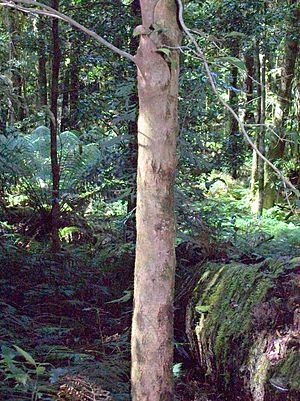Scrub ironwood facts for kids
Quick facts for kids Scrub ironwood |
|
|---|---|
 |
|
| Scrub ironwood at Barrington Tops National Park, Australia | |
| Scientific classification | |
| Genus: |
Gossia
|
| Species: |
acmenoides
|
| Synonyms | |
The scrub ironwood (scientific name: Gossia acmenoides) is a special kind of tree. It belongs to the Myrtaceae family, which includes plants like eucalyptus. This tree grows naturally in the rainforests of eastern Australia. You can usually find it in parts of the rainforest that are a bit drier. It grows from Jamberoo in New South Wales all the way up to Eungella National Park in northern Queensland.
Contents
What's in a Name?
The scientific name Gossia honors Wayne Goss. He was a former leader, or premier, of Queensland. He was known for supporting nature and protecting the environment.
The second part of the name, acmenoides, means that this tree looks like plants from the Acmena group. Many plants from the Acmena group are now called Syzygium. The leaves of the scrub ironwood actually look a lot like the leaves of a lillypilly called Syzygium smithii.
Discovering the Scrub Ironwood Tree
The scrub ironwood is usually a small tree or a large bush. It often grows to about 8 metres (25 feet) tall. That's about as tall as a two-story building!
Trunk and Bark Features
The trunk of the scrub ironwood often has many stems. It can also be a bit crooked, not perfectly straight. The biggest trees can reach about 20 metres (60 feet) tall. Their trunks can be around 30 centimetres (12 inches) wide.
The trunk is usually not perfectly round. Its bark is smooth and a pale fawn color. Sometimes, you might see darker, chocolate-colored patches on the trunk. The outer bark can have thin, paper-like pieces that peel off. The smaller branches are smooth and brown.
Leaves of the Scrub Ironwood
The leaves of this tree grow in pairs, opposite each other on the stem. They are simple, meaning they are not divided into smaller leaflets. Their edges are smooth, not toothed.
Each leaf is about 2.5 to 7.5 centimetres (1 to 3 inches) long. They are also about 1 to 3.5 centimetres (0.4 to 1.4 inches) wide. If you look closely, you might see a few large, scattered oil dots on the leaves. These can be seen with a magnifying glass or even with your eyes. The main vein in the middle of the leaf sticks out on both the top and bottom surfaces. There's also a clear vein that runs all around the edge of the leaf.
Life Cycle of the Scrub Ironwood
Small white flowers start to appear on the scrub ironwood from November to April. After the flowers, the tree produces small black berries. These berries have three to five seeds inside. They usually ripen between February and April. It can be tricky to grow new scrub ironwood trees from seeds or from cuttings.
See also
 In Spanish: Árbol pitón para niños
In Spanish: Árbol pitón para niños

